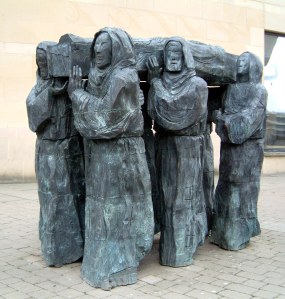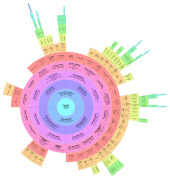Tarset and Tarret Burn
Hard and Heather Bred
GYet! GYet! GYet!
A Border Reiver cry from North Tynedale
(GYet means clear the way)
My maternal grandmother, Jessie Margaret Dodd was born in 1899 in Vankleek Hill near the Ottawa River in Eastern Ontario. Jessie’s paternal ancestry can be traced to her great great grandfather, Adam Dodd who was born about 1779 in the village of Glassonby, in Cumberland (Cumbria), England. His birthplace was a short distance south of “The Debatable Lands” and Hadrian’s Wall, on the English side of the Anglo-Scottish border.
Although I have not found a record of the event, Adam was likely baptized at St. Michael and All Angels Anglican Church in Addingham Parish which is where he married Agnes Biggins in 1813 and where seven of their children were baptized before the family emigrated to Canada in 1829. Adam was listed as a “labourer” not as a “yeoman”, on his marriage record and on the baptismal records of his children. The story of Adam and Agnes’ descendants in Canada is fairly well documented and will soon be found in another post. Adam Dodd is one of my “genealogical brick walls”. Records five generations before mine are rare and sparsely-detailed and so I have resorted to speculation and legend to trace my Dodd ancestry further back. This is a prerogative of an amateur genealogist.
Although I do not know the name of Adam’s father, I estimate he would have been born in the mid-1700s and married in the 1770s. There are a few potential paternal candidates from Glassonby and nearby villages in this time period, but none apparently named Adam. One, named John married in 1773. In 1818 in Glassonby there were two babies baptized John Dodd; one, the son of a Hugh Dodd and the other the son of my Adam. The whole parish (in 1811) only contained 118 inhabited houses, and 550 inhabitants”, so there is very likely a family connection here but, it would be pure speculation to say that Adam’s father was John and his brother was Hugh.
A Will and Administration reference from 1664 seems to be the first record of an Adam Dodd in Addingham parish. He was apparently from Ainstable, a village about five miles north of Glassonby. The earliest record I have found for any Dodd (Dod) in the parish was for the baptism of the son of William Dod, Robert, on the 9th of February 1606 at Kirkoswald, a couple of miles up the road from Glassonby.
But two hundred years before Robert Dod was baptized in Cumberland the Dodd surname was already well established in Tarsetdale and Tarretdale in neighbouring Northumberland. The name is recorded in court documents from 1397 offering pardons by Henry Percy, the first Earl of Northumberland to three Dodds accused of thievery.
 The Dodds, Robsons, Milburns and Charltons were the four Border Reiver surnames (clans), collectively known as the “Tynedale thieves”. Effectively these were kinship-based self-protection groups which emerged as a result of the chronic insecurity of prolonged Anglo-Scottish conflict in the Borderlands. These groups provided some measure of security for the valley’s inhabitants during these turbulent times through the threat of collective retaliation and feud.
The Dodds, Robsons, Milburns and Charltons were the four Border Reiver surnames (clans), collectively known as the “Tynedale thieves”. Effectively these were kinship-based self-protection groups which emerged as a result of the chronic insecurity of prolonged Anglo-Scottish conflict in the Borderlands. These groups provided some measure of security for the valley’s inhabitants during these turbulent times through the threat of collective retaliation and feud.

Black Middens Bastle Probably similar to the fortified farmhouse the Dodds might have lived near present-day Burbank Farm © Copyright Mike Searle and licensed for reuse under Creative Commons Licence
Border Reiver families built fortified farmhouses (bastles) or tower (pele) houses and the Dodds are associated with such a fortification at Burnbank in Tarsetdale (Dodds, John F., 1999, Bastions and Belligerents,Newcastle upon Tyne: Keepdate Publishing) p. 295). Although the exact location and layout of the tower or bastle has not been confirmed, foundation stones on Burnbank Farm near Greenhaugh have been identified. The latitude and longitude of the ruins are 55.181973,-2.3298993 .

The Journey Fenwick Lawson Photo by Jon Edgar
But the lengendary origins of the Dodd surname in Northumberland go back from their border reiving period (1400-1600) to the Dark Ages (late 9th century) and a young neophyte monk named Eilaf in the monastery of the community of St. Cuthbert on the island of Lindisfarne. Under constant threat of Viking raids the monastic community, abandoned the Holy Island around 875 carrying with them St. Cuthbert’s body, relics, and books including the Lindisfarne Gospels. Over the next seven years the monks wandered Northumberland carrying the coffin from place to place.

Looking for Eilaf. See any family resemblance?
According to a folktale retold a thousand years later in 1871 by Edward Charlton in Memorials of North Tyndale, and its four surnames,
“they transported it till their number by famine and desolation was reduced to four. And one of these was Eilaf and he and his companions were exhausted by hunger and they had no food save the salted head of a horse and a single cheese. And Eilaf longed for this cheese till so great was his desire thereof that he hid it and began to eat thereof. And at noon the bearers of St Cuthbert’s body rested in a desert place and sought to make their midday meal and behold the cheese on which they had relied was missing Then the brethren prayed that the thief might be changed into a fox and so there issued straightway from the wood a fox with the identical cheese in his jaws which the animal vainly tried to devour and as vainly to get rid of and much laughter did this cause unto the brethren and it was noted that Eilaf who had stolen the cheese was absent And they knew that he now writhed before them in the shape of a fox and they having been sufficiently amused did pray to God and to St Cuthbert to restore to him his human shape and from that day all the race of Eilaf bore the name of Tod (Dodd) which in the mother tongue signifies a fox.”
It seems that stealing cheese was not the only indiscretion of Eilaf Dodd for his sons and their descendants went on to become the Tynedale Thieves.

When James VI of Scotland became James I of England in 1603 he executed, banished or dispersed the Border Reivers including the Dodds.
The union of the Scottish and English crowns in 1603 erased the border between Scotland and England from the map of the united kingdom. It also marked the beginning of the end of the border reivers. In the decade following this historical turning point the Dodds and the other reiving surnames were executed, banished or fled North Tynedale. Amongst those who fled might have been my Dodd progenitor, (possibly William mentioned above) who settled in Addingham Parish, Cumberland.
Speculation and folktales are not the best ways to scale a genealogical brick wall but they make for a good story.





Well done. I do not know if our Dodds family and your connect but I appreciated this research of your very much. John Dodds b. 1764 in Antrim Ireland. Died in North Hero Vermont in 1832. We are doing some Y-dna testing to see if we can find a thread to follow back before this brick wall of our own. Thank You,
Kim